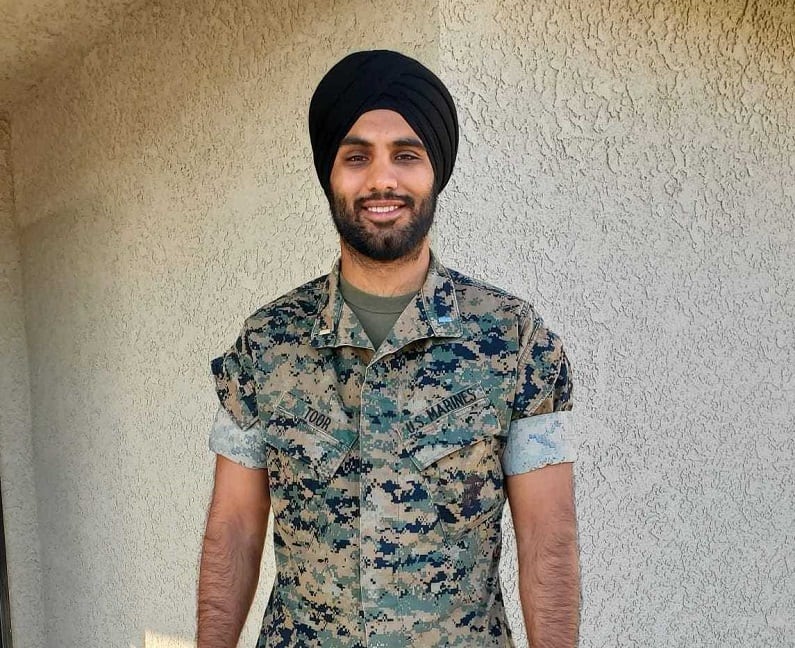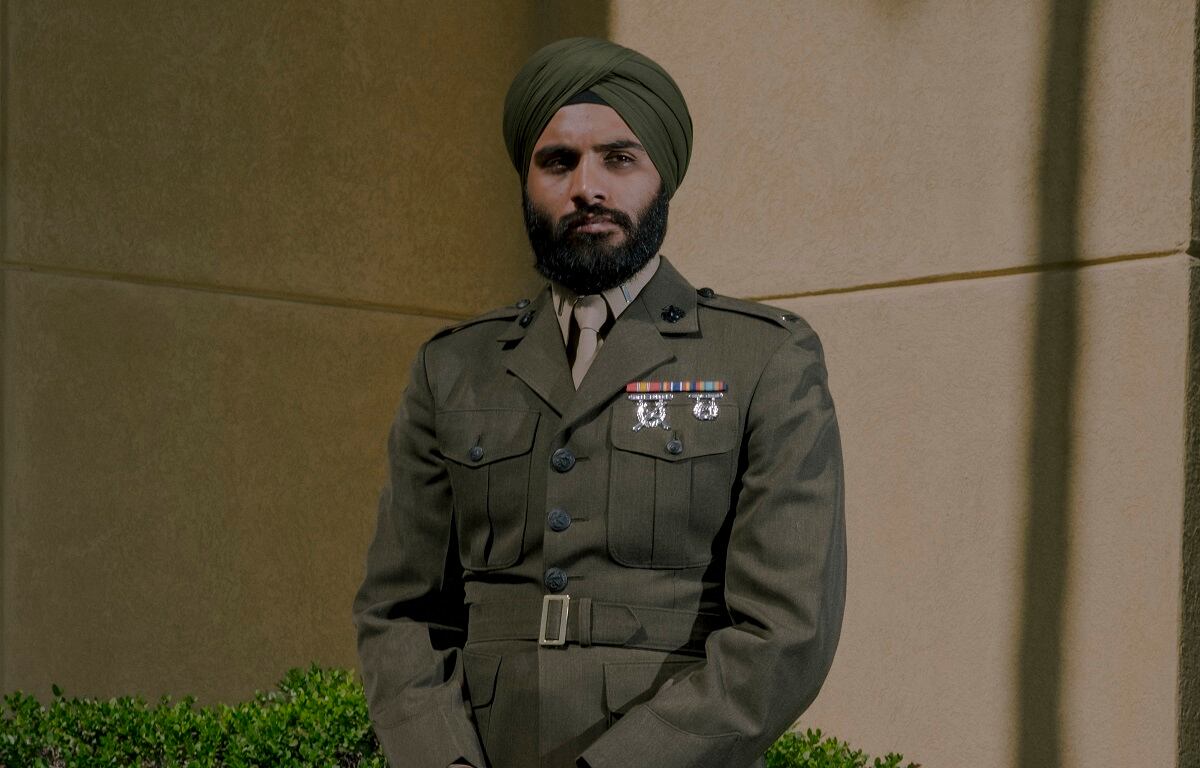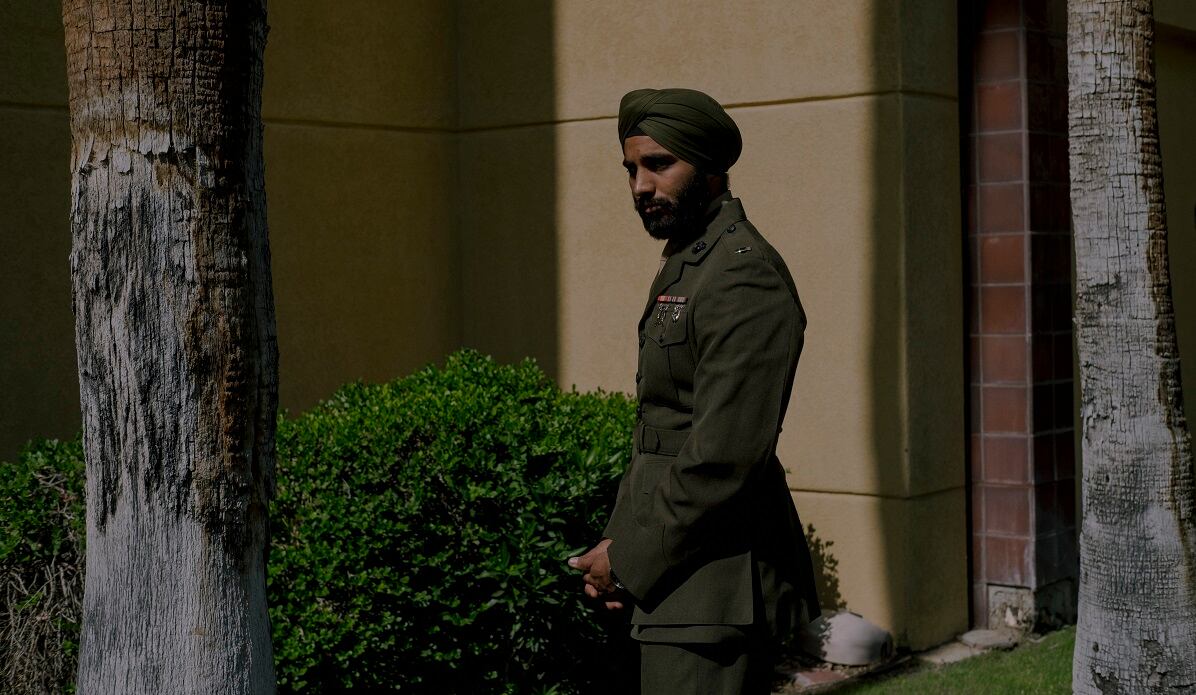In late September, 1st Lt. Sukhbir Toor, an officer with 3rd Battalion, 11th Marines, stationed in Twentynine Palms, California, donned a turban in his Marine Corps uniform for the first time.
But the limits placed on him by Manpower and Reserve Affairs have caused the Marine to appeal to the commandant and consider a lawsuit.
The young artillery officer cannot wear a turban while “assigned to lead an artillery unit or fire support team,” said letter of approval from Lt. Gen. David Ottignon, the head of Manpower and Reserve Affairs, and published by The New York Times.
He cannot wear one while forward-deployed in any role or in a ceremonial unit “where the uniform conveys a public-facing message.”
RELATED

The letter was dated in June and triggered an immediate appeal by Toor.
In August, the Corps relented slightly, but the Marine is still banned from wearing his articles of faith while deployed to a combat zone or when in dress uniform in a ceremonial unit. He is allowed to wear it while his unit is in garrison.
The Marine Corps has received 33 requests for uniform or grooming religious accommodations, Maj. Jordan Cochran, a spokesman for Marine Corps Manpower and Reserve Affairs, told Marine Corps Times on Nov. 2.
“Their status is as follows: 17 approved, 2 partially approved, 4 conditionally approved, 2 withdrawn, 7 denied, and 1 pending,” Cochran said in an email. “In 2014, DoD updated the force-wide requirements for accommodating religious practices in the military services.”
The approval of religious accommodations reflects “the high value that DoD places on the rights of service members to observe the tenets of their religion, or to observe no religion at all,” Cochran added.
The Marine Corps has not explicitly said how beards or turbans pose a risk to unit cohesion, endangers the lives of Marines or hurts recruiting efforts.
“Look, I’m on the ground level with the trigger-pullers every day,” Toor told the Times.
“To them, I don’t think it makes a difference. We have men, women, people of all races in my platoon. We all wear green, we all bleed red. My Marines didn’t respect me because of what I had on my head.”
Not far enough
Religious accommodations have been a hot topic in recent months, as thousands of service members have been applying for religious accommodations to get out of the COVID-19 vaccine requirement on the basis of their faith or sincerely held beliefs.
As of early November, the Marine Corps had not accepted a religious accommodation for the COVID-19 vaccine or any other required shot. (See “Vaccine exempt” for more on religious exemptions with the coronavirus vaccine.)
In Toor’s case, with his turban and hair, the increased religious accommodation is positive but it does not go far enough, according to a senior staff attorney with the Sikh Coalition, which represents the Marine legally.
Given the importance of deployments to Marine officers in combat jobs, like artillery, the accommodations essentially are making Toor choose between his faith and his career, attorney Giselle Klapper said.
“Here what they’re saying is, ‘You just can’t deploy period,’” the lawyer told Marine Corps Times Sept. 27. “The idea of deploying is almost the nature of what you do as a Marine.”
Klapper said Toor’s other attorneys have sent a letter to the Marine Corps on his behalf asking for full accommodation — modifications similar to those that Sikh soldiers or airmen receive in the Army or Air Force.
In 2017, after lawsuits and several requests, the Army changed its policy to allow Sikh soldiers to keep unshorn hair, beards and wear turbans while in uniform under almost every circumstance, ending a ban that was put in place in the 1980s.
Army Lt. Col. Kamal S. Kalsi was one of the soldiers who pushed the service to make a change.
“The turban and the unshorn hair, it’s really a physical representation of our spiritual beliefs,” Kalsi said in a phone interview. “It represents our connection to our spirituality, it’s not like a hat that can just be taken off.”
“My turban, my hair, the beard, it’s part of my faith, it belongs to my god,” said Kalsi, also the president of the Sikh American Veterans Alliance, an organization working to ensure religious Americans are allowed to fully practice their beliefs in uniform.
The Sikh religion comes with five official articles of faith, which include “kanga,” a small knife or ceremonial sword called “kirpan,” cotton “soldier shorts” or slightly longer underwear called the “kachera,” a small steel bracelet known as a “kara,” along with going without cutting their hair or beard, known as “kesh.”

The articles were introduced in 1699 by guru Gobind Singh, and act as a reminder that Sikhs are expected to defend the needy and oppressed even if that means taking up arms.
Though the turban is not one of the five articles of faith given to Sikhs by Singh, it has long been worn in the faith and is as important to many Sikhs as the other five articles.
“Perhaps the best analogy (though admittedly an imperfect one) is that of a wedding ring: one cannot reduce the significance of a wedding ring to its instrumental value; rather, one cherishes the wedding ring because it is a gift of love from one’s partner,” the Sikh Coalition website says.
“Similarly, Sikhs cherish their articles of faith primarily because they see them as a gift from their beloved Guru. Trying to understand these articles on the basis of their function is missing the point.”
Toor joined the Marine Corps in 2017, but waited five years until he was on the promotion list to captain to request the religious accommodations, believing it was wrong to ask before he gave anything to the Corps.
“I felt there was a debt to be paid,” Toor told the Times.
“My family came to this country seeking the American dream, and we got it.”
Toor grew up in the U.S., the child of Indian immigrants.
After the Sept. 11, 2001, terrorist attacks, Toor saw firsthand how his community became the target of some Americans seeking revenge and associating Sikhs with radical Muslim terrorists, he told The New York Times.
On Sept. 15, 2001, Balbir Singh Sodhi, a devout Sikh living in Mesa, Arizona, was murdered by Frank Silva Roque, a white man who said he was “going to go out and shoot some towel-heads.”
The incident was not an isolated one.
The Sikh Coalition said it documented more than 300 cases of violence or discrimination directed toward Sikhs in the months after Sept. 11, 2001.
Toor told the Times he hoped his service would help differentiate himself and his community from the people who committed the terrorist attack, the very people he is fighting against as a Marine.
Army Maj. Simratpal Singh was unable to wear his articles of faith until five years into his career.
“When I got the permission from the Army it was surreal,” said the West Point graduate and former Sikh Coalition client who sued the Army in 2016 to wear his articles of faith.
“I had two different worlds, there was the world that I was living which was my Army world and there was a world of my faith, so I was able to finally merge those two worlds into one.”
Kalsi said that Toor is going up against a service that is more conservative than the Army he challenged in 2016.
“Marines, and the Navy as well, have been a lot more conservative in these things in uniform policies,” Kalsi said.
Kalsi said Sikh American Veterans Alliance is helping several Sikh sailors and Marines apply for and receive religious accommodations.
Klapper said she hoped that with the precedent set by the Army and Air Force that the Corps would quickly accept Toor’s request.
“Because there is such precedent and such proof positive, one would hope that it would make the third or fourth branch you’re trying to work on easier than the first one,” Klapper said.
But she said she knew that the Corps’ culture of uniformity would make this a difficult fight.
The Corps’ image
The Corps is known for its clean-cut image and iconic dress blue uniform, and seeks uniformity just about everywhere Marines are seen in public.
In late October in an effort to increase recruitment and retention, the Marine Corps changed its policy on tattoos, which will allow more visible ink on Marines.
But the policy change came with a caveat that ceremonial units and certain public facing billets may still bar those with visible tattoos from joining.
Allowing Toor to wear a turban or grow a beard in a ceremonial unit would hurt the Corps’ recruitment efforts, the Marine general said in his letter allowing Toor to wear a turban or beard in other circumstances.
It also would hurt the Corps’ ability to reassure leaders that it was “creating a cohesive group of warriors capable of defending the nation’s interest,” Ottignon wrote.
The Marine Corps has not provided clarity or data showing on how it would hurt recruitment.
RELATED

Klapper found those arguments outrageous.
“We’re saying the reason you can’t serve, or you can’t maintain your religious identity, the reason we have to erase essentially your religious identity is because you are in a public facing role,” the lawyer said.
“That to me is problematic because in reality it’s not, under the law, a reasonable argument and it’s also just extremely outdated.”
Kalsi argued allowing Sikhs to wear religious clothes and symbols would likely bolster recruitment and serve as a reminder that the Corps represents all Americans.
Kalsi said his religion teaches to stand up for those who “cannot defend themselves.”
Though Sikhism started out as a pacifist religion in the late 15th century, in the wake of sometimes violent oppression, Sikhs developed a concept of just war and a culture that required them to fight against oppression when no peaceful form of justice was available.
Given the religion’s internal call for service and sense of military duty, Kalsi said there are “hundreds” of recruits who would be willing to join the Marine Corps if they were allowed to actively practice their religion in the ranks.
There are currently between 500,000 and 700,000 Sikhs living in the U.S., and as the Corps looks to increase diversity, they could be a community to reach out to.
“The American people need to know their military … reflects those they support and defend,” Brig. Gen. A.T. Williamson director of Manpower, Plans and Policy, said in August.
Marine Corps Commandant Gen. David Berger said the Corps is planning on putting the well-being and development of Marines first as it changes its manpower philosophy.
“The system you and I work in right now views you and me as inventory,” Berger said at a Marine Corps Association event Sept. 21.
“Every single individual Marine has unique a unique background we need all that, that individual brings to the fight.”
Allowing Toor to wear the physical manifestation of his religion while in uniform at all times is an opportunity for the Marine Corps to follow through on that promise, Kalsi said.
“What better ways to present your values to the American public than to say, ‘Look, we embrace diversity and inclusion, our Marine Corps looks like the America that it serves.”
Beyond beards and turbans, the Corps is also the last holdout in the U.S. military to allow women to wear ponytails while in uniform.
In 2018 the Navy changed its uniform regulations to allow the hairstyle, while the Army, Air Force and Space Force all followed suit in January. The Coast Guard allowed the change in July.
The Marine Corps has considered changes to its hair policy in 2021, Capt. Sam Stephenson, a Marine Corps spokesman, emailed Oct. 28.
But no final decision has been made as the decision is being processed through Headquarters Marine Corps.
“The most recent board considered several items, including grooming standards for men and women, to include hair regulations,” Stephenson said.
‘We can still serve honorably’
Beyond suggesting the turban and beard may tarnish the image of the Corps, Ottingon said if worn in a combat unit the lives of Marines would be put at risk.
“Uniformity is more than the mere outward expression of unity with the team,” Ottignon wrote. “It is a tool that constantly reminds each Marine of the team to which they are committed and a signal to other Marines of depth of that commitment.”
“The Corps cannot experiment with the components of mission accomplishment in forward units without assuming the risk of mission failure. The real world consequences of the failure of a forward deployed Marine unit, such as the one you lead, could jeopardize the lives of Marine and those relying on them to complete their mission.
The Marine Corps has not yet given Marine Corps Times an example of where variations in uniform have put lives at risk.
Kalsi, who deployed to Helmand province in Afghanistan in 2011 with the Army’s 44th Medical Brigade, found that notion ridiculous.
Accommodations to be able to wear helmet can be made, and experiments Kalsi participated in a gas mask showed it was possible to create a seal even with a beard.

After changing its policies for Sikhs, the Army studied whether beards would prevent a seal on the M50 joint service general purpose mask, though the branch has yet to release results.
However, a 2018 study on half-face respirators, frequently used in the civilian world when working with potentially toxic chemicals, fumes or sprays, found a seal was formed for 98 percent of tests when participants sported an 1/8 inch beard.
Kalsi says the U.S. military and its multicultural allies already have won a war showing that physical uniformity does not make a superior fighting force.
“We defeated the Nazis, and they were way more uniform than we ever were,” Kalsi said.
“It’s not about uniformity of what you look like, it’s about uniformity of mission and uniformity of your values.”
In World War I and World War II at least 83,005 Sikhs died while fighting, mostly for the British Armed forces.
RELATED

“Guess what, they had their turbans and beards,” Kalsi said. “If we could bleed and die then, I think we can still serve honorably, we can figure this out and we can do it in a way that’s safe,” Kalsi said.
Klapper said that multiple clients of the Sikh Coalition have deployed with the Army to combat zones while wearing turbans and beards without posing a single safety issue.
“I know they do it in the Army, I know they do it in certain circumstances where they are fighting in a combat environment side-by-side with their Marine brothers, this is a reality,” she said.
Since 2017, soldiers seeking to wear turbans or hijabs must submit a request with explanation of their sincerely held religious belief for brigade level approval.
Sikhs who have their request approved by the Army must keep beards under 2 inches, measured from the bottom of the chin. Turbans must completely cover the soldier’s hair and be a subdued color that matches the uniform.
Patterns are not authorized unless the soldier is wearing the camouflage uniform, in which case the pattern must match the camouflage pattern with the exception of soldiers in Ranger, special operations forces or airborne units, who will be allowed to wear a tan, green or maroon turban that matches the unit’s beret.
Beards are banned from schools that require soldiers to complete toxic chemical agent training, nor can those soldiers be assigned to positions requiring compliance with biological, chemical or nuclear surety requirements, as outlined in Army regulations.
Sikhs may also be required to shave their beards if a specific threat of chemical or toxic exposure is found during their combat deployment.
The Marine Corps has not yet replied to Toor’s most recent appeal, Graham West, a spokesman for the Sikh Coalition told Marine corps Times on Oct. 25.
“We continue to await a response from the Marine Corps — accordingly, we don’t have anything more specific about timeline for litigation at this time,” West said in an emailed statement.
Klapper said she hopes to work with the Marine Corps to come to an acceptable solution, but if the Corps fails to reply or agree to acceptable accommodations the attorneys are prepared to take the battle to the courts.
While deployed to Afghanistan, Kalsi was treating Marines wounded while fighting the Taliban in the region.
“We took care of hundreds of combat casualties and not a single one of those combat casualties ever gave a shit that I had a turban or a beard,” he said.
Editor’s note: This story has been updated to add some additional responses from the Marine Corps.





